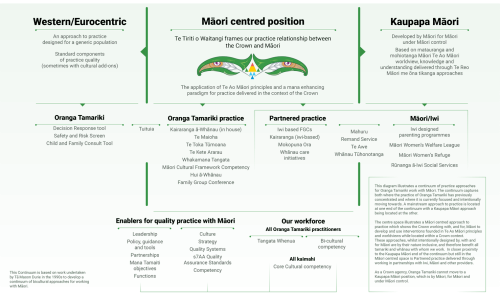Our practice approach
Our practice approach is framed by te Tiriti o Waitangi (the Treaty of Waitangi) and supported by a mana-enhancing paradigm for practice and draws on Te Ao Māori principles of oranga (wellbeing).Tohu for Oranga Tamariki practice
Tohu have been used by Māori through the generations to convey meanings of significance.

View full size image (PNG 514 KB) Download image (PNG 514 KB)
Core elements of our practice approach
Our approach helps us work more effectively with tamariki and whānau Māori. However, the mana-enhancing paradigm and Te Ao Māori principles of oranga (wellbeing) are relational, inclusive and restorative, and therefore have benefits for all children and families.
A mana-enhancing paradigm for practice recognises that it is possible to undertake our challenging and complex mahi in a way that is respectful, relational and restorative. The mana-enhancing paradigm has a strong foundation in social work practice in Aotearoa New Zealand and embodies 5 core components:
- Te Ao Māori is valuable knowledge – it helps guide and enhance our relationships with tamariki/mokopuna, rangatahi and whānau.
- The significance of history – through which underlying and intergenerational trauma and resilience can be understood.
- Valuing narratives as cultural identity helps to understand what tamariki/mokopuna, rangatahi and whānau experience, value, identify and connect with.
- Māori concepts of wellbeing are critical to understanding, maintaining, restoring and strengthening oranga.
- Principled practice means knowing and understanding the influence of who we are, and why we think and behave the way we do in our practice.
Māori-centred social work practice | orangatamariki.govt.nz
Te Ao Māori principles of oranga (wellbeing) are central to Oranga Tamariki social work practice. They help us understand the journey of oranga for all tamariki, families, whānau, hapū, iwi and family groups we work with.
How we are approaching our practice
We are moving from a predominantly western, eurocentric practice position to a Māori-centred position. This involves:
- supporting and developing our kaimahi to embrace our practice approach
- enabling Oranga Tamariki systems to support our practice approach and reduce inequities
- enabling our partners to practise effectively with tamariki, whānau, hapū and iwi.
Drawing from Tā Mason Durie’s Bicultural Continuum, the practice continuum diagram was created in 2019 to support our practice shift. The practice continuum diagram served to illustrate the band of bicultural approaches for working effectively with Māori. The practice shift places Oranga Tamariki mahi at the centre of the continuum because this position is inclusive, supporting best practice for all ethnic groups. The continuum is an important part of the whakapapa of our practice approach.
Resources for applied practice
Engaging in courses, reading and other activities contributes to your SWRB CPD log.
Can't find what you're looking for? Try the search bar or view policies.

